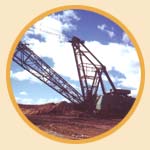Surface
Mining
 Surface
mining is the primary
method used to extract coal and bitumen reserves found in Alberta. Although not
widespread, surface mining involves an intense, local alteration of the
landscape, the removal of large quantities of overburden (soil, glacial till
bedrock) to expose the hydrocarbon resource buried
beneath. When mining
operations are completed, they usually leave a series of open pits that must be
reclaimed. Surface
mining is the primary
method used to extract coal and bitumen reserves found in Alberta. Although not
widespread, surface mining involves an intense, local alteration of the
landscape, the removal of large quantities of overburden (soil, glacial till
bedrock) to expose the hydrocarbon resource buried
beneath. When mining
operations are completed, they usually leave a series of open pits that must be
reclaimed.
Surface mining is
best suited to widespread fault seams of materials, such as clay and coal,
or compact near-surface bodies, such as some types of uranium. The choice of open
pit mining or underground mining in the case of uranium depends on the depth of
the deposit, how easily the rocks and soil on top of the ore can be removed and,
finally, economics, as the amount of overburden that must be removed to expose the
seam varies.
Surface mining
is generally less costly and more flexible than underground mining. This type of
mining also recovers a higher percentage of coal in a deposit. This type of
mining involves removing the topsoil or surface earth, also called overburden,
from the area to be mined. This is often done with huge draglines that have buckets.
The cover soil removed is stockpiled for later reclamation. Up to 69 cubic
metres of earth may be removed, all at one time. Sometimes the use of explosives
is required to crumble the overburden. Stripping the topsoil reveals the coal
seam. The coal seam is then mined using "shovels". These shovels can
remove up to 16 cubic metres of coal at one time.
Generally,
extraction technology in non-mountainous areas involves the use of massive
draglines in order to remove the overburden and expose the coal seams. Power
shovels and trucks are used to haul the coal to a nearby processing facility.
Some general environmental pressures include noise levels (machinery, blasting),
air quality (coal dust), water quality and stream diversions, soil and
vegetation removal. Reclamation of open pit coal mines tends to be more
difficult in mountainous areas because of the naturally shallow soil depth and
greater variations in topography.
 
|
|
 Heritage Community Foundation Presents
Heritage Community Foundation Presents





